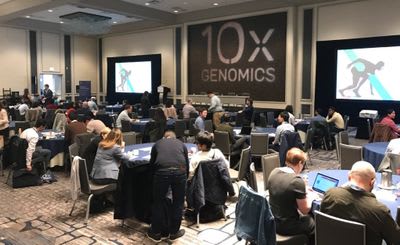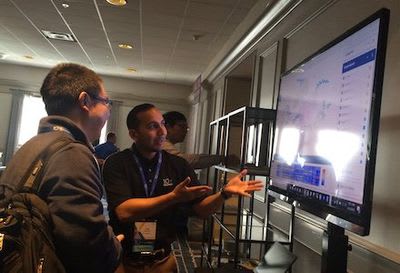Blown away by customer research presented in the Windy City

Our 3rd North American User Group Meeting of the year took place last Thursday, April 26th, in Chicago, and we were thrilled to see so many members of the 10x community there! It was a great turnout, with over 120 customers and researchers from throughout the Midwest in attendance. UGMs are a great opportunity for us to connect with our customers and, even better, to connect our customers with each other. Last week’s attendees in Chicago got to hear all the latest 10x news, with a 10x-pert panel discussion and presentations from 10x-ers Chris Black and David Lin. David showcased our powerful bioinformatics software and Chris highlighted some exciting new developments in our product portfolio, including the recently launched single cell CNV solution. But the real stars of the show were the 5 customers who presented the fascinating research they’ve been doing with 10x technology.
The first four customer presentations featured research projects that utilized the Chromium Single Cell Gene Expression Solution. Ekaterina Esaulova, researcher and graduate student in the Max Artyomov Lab at the Washington University School of Medicine, kicked off our customer talks presenting her research to examine Immune checkpoint blockade-mediated tumor rejection in a mouse model. Results from her gene expression profiling of >14,000 CD45+ cells revealed 19 cell clusters, including 5 distinct clusters of macrophages. This unexpected level of macrophage differentiation was validated at the level of protein expression using a CyTOF immunophenotyping protocol, and she is now working with human samples to determine if the macrophage complexity observed in the mouse model is relevant to human health.
Next up, Dr. Sathiya Pandi, Post Doctoral Fellow in Dr. Arul Chinnaiyan’s Lab at the Michigan Center for Translational Pathology presented his work on renal cell carcinomas (RCC). Dr. Pandi used single cell gene expression profiling to delineate the cell type composition in clear cell renal cell carcinomas, revealing the expected tumor cell types as well as a significant proportion of macrophages. Next, focusing on a set of candidate genes identified from published literature, he analyzed the RNA expression data in RCC cells and found evidence of copy number changes for these candidate, with different genes affected in different RCC subtypes. These copy number variants were then validated with exome sequencing. In ongoing work, Dr. Pandi is using gene expression profiling to investigate the hypothesis that the different subtypes of RCCs originate from distinct cell lineages present in the normal kidney.
Leading off the afternoon session, Dr. Alexander V. Misharin, Assistant Professor of Medicine at Northwestern University, presented, 'Single-cell transcriptomic analysis of the human pulmonary fibrosis.' To study the mechanism of this poorly characterized disease, Dr. Misharin’s team performed single cell transcriptomic analysis of cells obtained from 8 healthy donor lungs, the fibrotic lungs of each transplant recipient, and one bronchoscopic cryobiopsy sample. Using Seurat to analyze the data compiled from these experiments, the team identified distinct populations of epithelial cells and macrophages that were common to all patients with lung fibrosis, and further discovered fibrosis-associated transcriptional changes in every cell type identified. These results indicate that each cell type responds to fibrosis with cell type-specific, disease-associated molecular pathways.
Finishing off the single cell presentations, Dr. Kathryn E. Hulse, Research Assistant Professor in the Division of Allergy & Immunology at Feinberg School of Medicine-Northwestern University, presented 'B Cell Activation During Chronic Airway Inflammation.' Her lab uses tissue samples from patients with Chronic airway inflammation (CAI) as an experimental system for studying B cell inflammatory responses. To characterize the B cell population in these clinical samples, and B cell activation in general, Dr. Hulse and her team isolated B cells from CAI patient samples and profiled their gene expression at the single cell level, both at baseline and after coculture with ILC2 cells (known to B cell activators). The team has only begun to analyze the rich data set they’ve collected so far and are already making exciting discoveries, such as distinct B cell gene expression profiles for patients in different diagnostic groups. As she continues to hone her newly-acquired R skills and learn all the data analysis capabilities with Seurat, Dr. Hulse is already looking to us the Chromium Immune Profiling Solution to study the VDJ clonal phenotypes in these CAI derived B cells.
In the final presentation of the day, Dr. Robert Fulton, Assistant Professor of Genetics at the Washington University School of Medicine’s McDonnell Genome Institute (MGI), talked about work that various teams are doing with the Chromium Genome Sequencing Solution. As part of the NHGRI funded common diseases project, one team is using Linked-Reads and Supernova 2.0 to generate de novo assemblies for 500-1000 individuals from diverse ethnic backgrounds. During the packed presentation, Dr. Fulton also touched on MGI approaches for generating improved Reference assemblies (e.g. combining Linked-Read sequencing with long-range technologies, like BioNano mapping, Pac Bio and HiC) and also mentioned the incorporation of Linked-Read sequencing into some of the cancer genomics projects at MGI. Finally, he highlighted an ongoing genetic health study by Karyn Meltz Steinberg, who is using Linked-Read sequencing to characterize 16 probands that could not be solved with standard GenDx testing.

Thanks to everyone who came out to see us in Chicago! Our UGM season continues tomorrow in Houston (May 2nd), and later this month in New York (May 18th), and Boston (May 22nd). Visit our UGM information page to see the full list of our 2018 User Group Meetings and to register for a meeting near you. (Registration is Free!)
Additional Resources
-
Learn more about our gene expression and genomics solutions for:
-
de novo Assembly
-
Keep up to date on the latest 10x products including the new single cell products for CNV detection, ATAC-seq, and feature barcoding on our 10x Genomics website.
